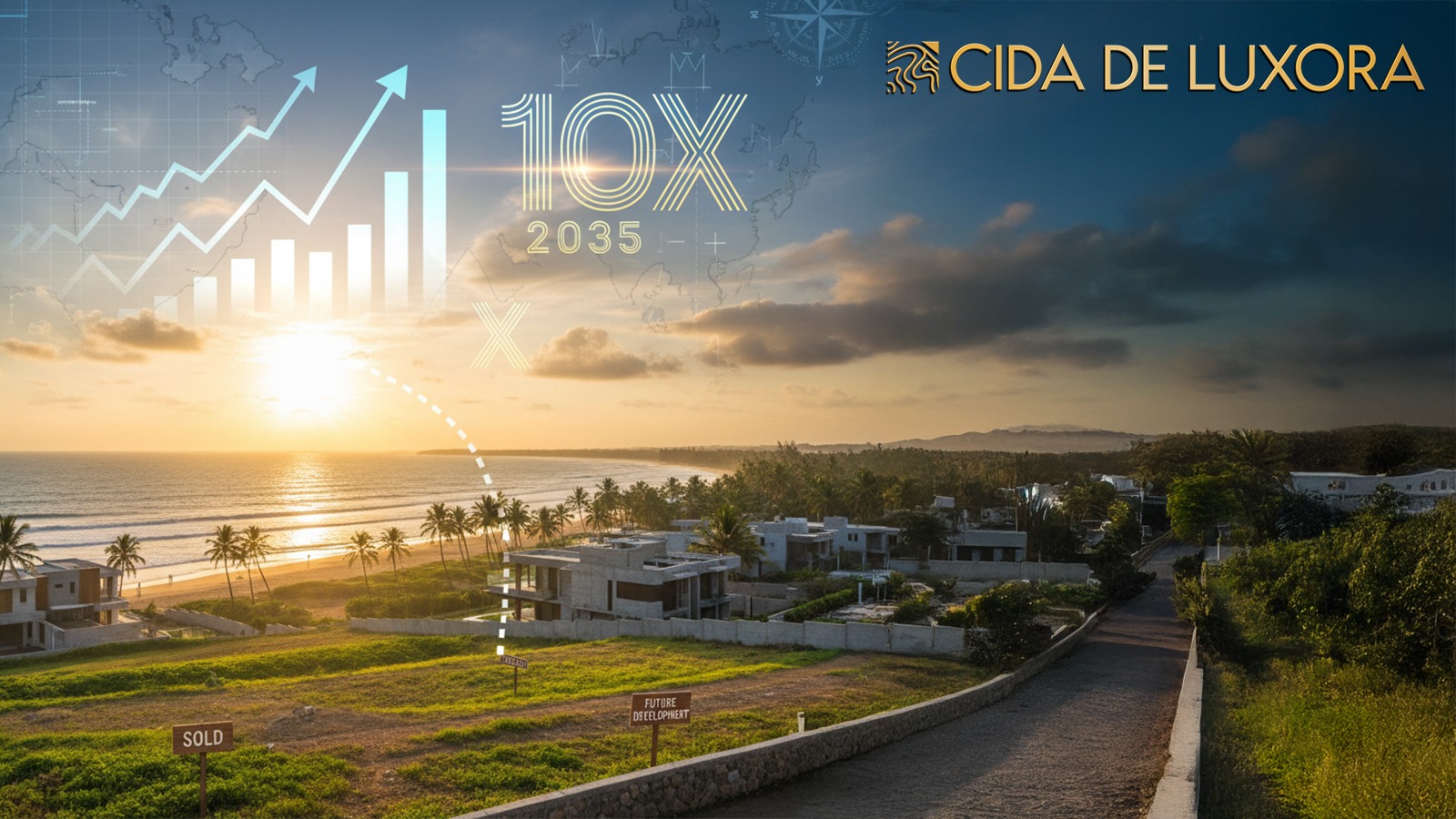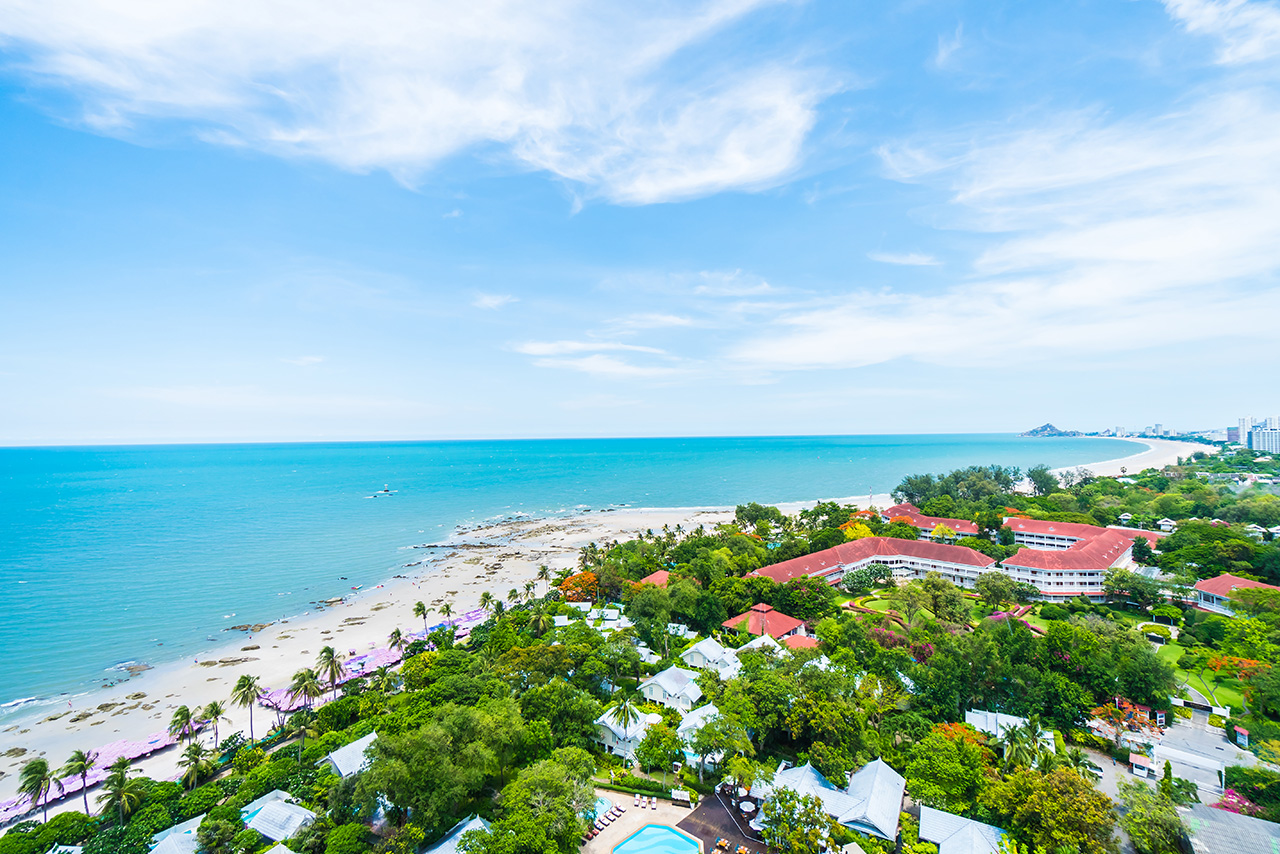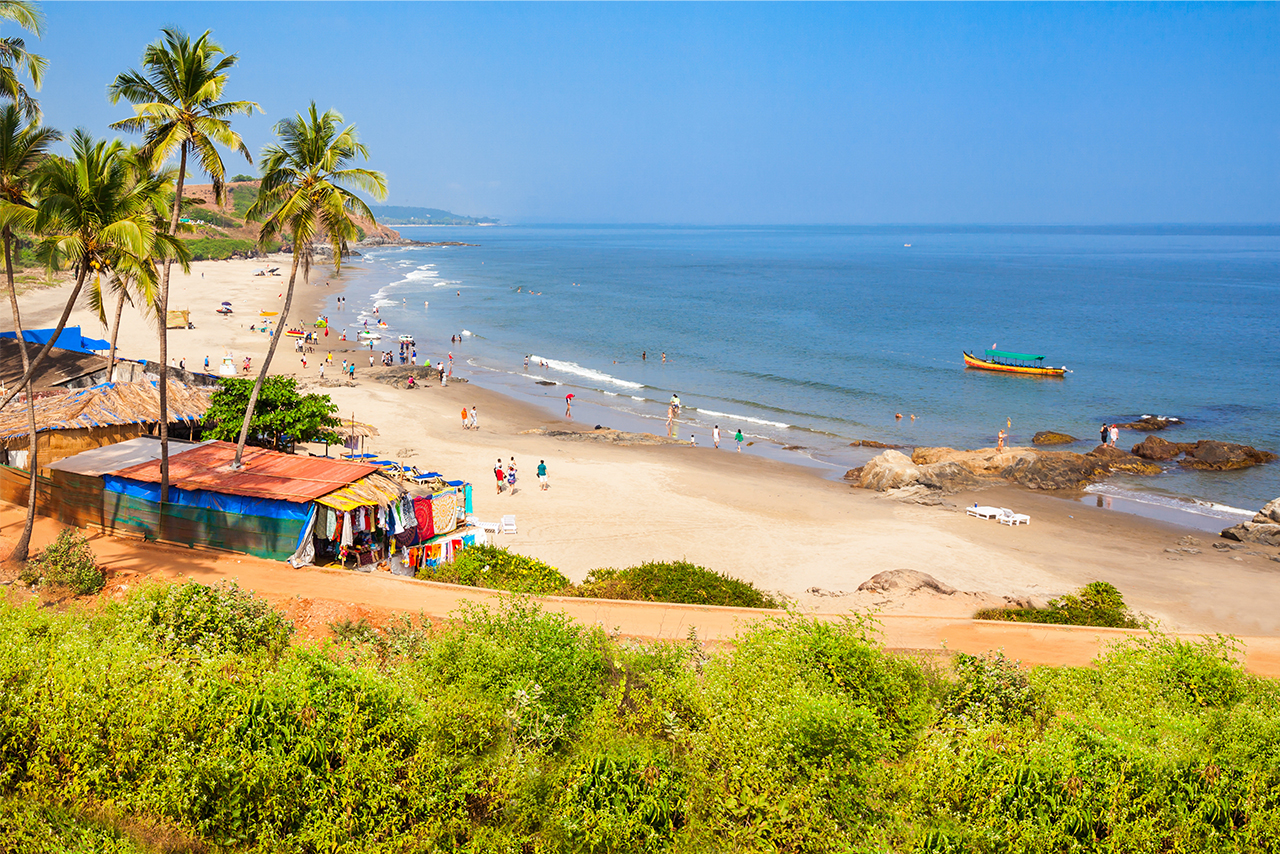Table of Contents
ToggleThe Secret Wealth Engine Hiding in Plain Sight
Picture this: It’s 2008. A young Mumbai entrepreneur buys a 2,000 sq ft plot in Anjuna, North Goa, for ₹60 lakhs. His friends call him crazy. “Too expensive,” they say. “Goa is just for vacations.”
Fast forward to 2020. That same plot? Worth ₹5 crores. That’s an 8X return in 12 years.
Now imagine you had a time machine. Would you go back and buy that plot?
Here’s the thing: You don’t need a time machine. What happened in North Goa between 2008 and 2020 is happening RIGHT NOW across coastal Goa, Sindhudurg, and Maha-Goa. And this time, the growth could be even more explosive.
Welcome to India’s coastal gold rush—where plots in Goa aren’t just real estate investments. They’re generational wealth creators disguised as vacation dreams.
Why This Time Is Different: The Perfect Storm of 2025
When 9.3 million tourists descended on Goa in 2023—including nearly 940,000 international visitors—they weren’t just bringing selfie sticks and sunscreen. They brought ₹ 14,000 crore+ into the local economy. That’s the GDP of a small nation, concentrated in India’s smallest state.
But here’s what the headlines missed: Tourism now drives 60% of Goa’s state revenue, making it the most tourism-dependent economy in India. And when an economy becomes THIS dependent on one sector, land values don’t just rise—they explode.
The data is staggering. According to The Economic Times, tourism contributes 17% to Goa’s GDP directly; however, when indirect impacts—such as construction, hospitality, transport, and retail—are factored in, the real number exceeds 40%. That’s higher than Dubai’s tourism GDP contribution (20%).
Translation? Every additional million tourists adds approximately ₹1,500 crores to Goa’s economy. With MOPA International Airport now operational and targeting 10 million or more passengers by 2030, we anticipate 13-15 million annual tourists within five years.
More tourists = More hotels = More villas = More demand for plots in Goa.
And that’s just the beginning.
The Water Tourism Revolution—From ₹800 Crores to ₹5,000 Crores by 2035
While everyone focuses on Goa’s beaches, something extraordinary is happening on the State’s rivers and coastlines. Water tourism in Goa has quietly become a ₹1,200+ crore industry, and it’s growing at a blistering 18-20% annually.
Goa Tourism Development Corporation data show that river cruises alone recorded over 620,000 passengers in 2023. Casino cruises, sunset dinner cruises, backwater tours, and luxury yacht experiences are now mainstream, not niche.
However, here’s the key statistic: The government has just approved ₹350 crores for coastal infrastructure development through 2027, including new jetties, water sports hubs, and maritime facilities. Business Today reports that Goa is positioning itself as India’s answer to Thailand’s Phuket for water-based tourism.
Adventure water sports—parasailing, jet skiing, scuba diving, kayaking, dolphin watching—are exploding at a 22% CAGR. According to ET TravelWorld, the water sports market in Goa is expected to reach ₹2,500 crores by 2028.
What This Means for Land Values:
Properties located within 2 km of water bodies, jetties, or beach access points are experiencing a 30-40% year-on-year appreciation. Why? Because these aren’t just land parcels anymore—they’re potential water villa resorts, river-view retreats, or yacht club communities.
In Sindhudurg and South Goa, where Cida De Luxora is strategically located, an undeveloped coastline still exists. As water tourism infrastructure develops, these plots could see a 5-7X appreciation in the next 5-7 years alone—before even reaching the 10-year horizon.
Coastal Tourism’s 60% Revenue Stranglehold—And Why It’s Accelerating
Here’s a number that changes everything: Coastal tourism growth in Goa isn’t just big—it IS Goa’s economy. India Today and state budget documents reveal that over 60% of state revenue flows directly from coastal tourism activities.
This creates what economists refer to as a “multiplier effect.” Every ₹1 spent by tourists generates ₹4-5 in economic activity through hotels, restaurants, transport, retail, real estate, and construction.
Goa now boasts 6 Blue Flag beaches—including Miramar, Calangute, and Kappad—meeting strict international environmental and safety standards. These certifications attract premium international tourists who spend three to four times more than domestic visitors.
Business Standard reports that average tourist spending in Goa increased from ₹8,500 per trip in 2018 to ₹15,200 in 2023. That’s 79% growth in just 5 years. Project this forward to 2035, and we’re looking at ₹30,000+ per tourist—creating a ₹45,000+ crore tourism economy.
The Land Play:
When state revenue depends THIS heavily on tourism, governments protect and promote coastal assets aggressively. This means:
- Better infrastructure near beaches
- Stricter regulations (raising entry barriers)
- Premium valuations for coastal proximity
- Long-term policy stability
Plots in Goa near Blue Flag beaches or upcoming coastal hubs aren’t just scarce—they’re government-backed scarcity. That’s the best kind for investors.
MOPA Airport—The Infrastructure Catalyst for 10X Growth
Let’s talk about game-changers. Manohar International Airport (MOPA) handled 4.6 million passengers in FY 2024-25. But here’s what the Airports Authority of India (AAI) projections show:
- 2025: 6.5M passengers
- 2027: 8.2M passengers
- 2030: 10-12M passengers
- 2035: 15-18M passengers
This isn’t speculation—it’s based on the Phase 2 expansion, which has already been approved, adding a second terminal and cargo hub.
History repeats itself. When Bangkok’s Suvarnabhumi Airport opened in 2006, land values within a 30-km radius surged 400-600% in the following five years. When Phuket International Airport expanded in 2012-2015, coastal land prices jumped 5-7X.
MOPA does something unique: It’s positioned in North Goa, but its catchment area covers South Goa, Sindhudurg, and parts of Karnataka—a 150 km radius. This means plots in previously “remote” areas like Maha-Goa suddenly become “1-hour from international airport” properties.
The National Highways Authority of India (NHAI) is building the NH-66 Expressway, cutting Mumbai-Goa travel to 6 hours (from 12). The newly approved Shakti Peeth Highway (announced in the Times of India, 2025) will connect Sindhudurg directly to Goa’s tourism circuit.
The 10X Math:
Infrastructure doesn’t just add value—it multiplies it. Properties near MOPA saw 35-50% appreciation in the first year post-opening alone. Extrapolate this with passenger growth, and you’re looking at:
- 2025: ₹10,000/sq ft (baseline)
- 2030: ₹35,000-40,000/sq ft
- 2035: ₹80,000-1,00,000/sq ft
That’s your 10X in 10 years.
Global Coastal Real Estate Playbook—Bali, Phuket, Maldives Are Your Crystal Ball
Want to know where Goa is headed? Look at Southeast Asia 10-15 years ago.
Bali, Indonesia:
- 2010: Beachfront land = $150/sq m
- 2020: Same land = $900-1,200/sq m
- Growth: 6-8X in 10 years (Travel & Leisure)
Phuket, Thailand:
- 2012: Coastal plots = ฿45,000/sq m
- 2022: Same plots = ฿280,000/sq m
- Growth: 6X in 10 years (CNBC Asia)
Maldives:
- 2015: Resort island leases = $8M
- 2024: Same leases = $45M+
- Growth: 5.6X in 9 years (UNWTO)
What did all three have in common?
- Airport expansion
- Tourism crossing 5M annually
- Water tourism is becoming mainstream
- NRI/expat demand surging
- Government policy support
Goa checks ALL five boxes. According to Mint, Goa is now officially categorised as a “Tier 1 Investment Destination” for international real estate funds—the first time a non-metro Indian region achieved this.
The NRI & Metro Magnet—40% of Buyers Aren’t Even Local
Here’s a stat that shocked even seasoned real estate analysts: 40% of second-home buyers in Goa come from Mumbai, Pune, and Bengaluru (ET Realty). Another 15% are NRIs from the UAE, the US, and the UK.
Financial Express ranks Goa among the Top 3 NRI destinations for real estate investment in India, behind only Mumbai and the NCR-Gurgaon region. Why?
The Work-From-Goa Movement:
Post-pandemic remote work changed everything. Housing.com data shows searches for “villas in Goa” increased 340% between 2020 and 2023. But here’s the twist—these aren’t vacation rentals. They’re permanent/semi-permanent relocations.
Tech professionals, entrepreneurs, and consultants are purchasing plots in Goa, constructing custom villas, and working remotely while enjoying access to the beach. They’re paying ₹15,000-25,000/sq ft happily because they’re comparing it to ₹45,000/sq ft in Mumbai suburbs.
Rental Yields Are Insane:
Coastal villas in Goa typically yield annual rental returns of 7-10% (99acres). In comparison:
- Mumbai: 2-3%
- Bangalore: 3-4%
- NCR: 2.5-3.5%
Buy a plot, build a villa, rent it on Airbnb for ₹15,000-35,000/night during season (Nov-March), keep it for personal use off-season, and you’re looking at ₹8-12 lakhs annual rental income on a ₹ two crore investment. That’s 4-6% cash flow PLUS 15-25% yearly appreciation.
North Goa’s Proven Playbook—The 8X Story That’s Repeating
Let’s get specific with real data from Magicbricks and ET Realty:
Anjuna, North Goa:
- 2008: ₹3,000/sq ft
- 2015: ₹12,000/sq ft
- 2020: ₹25,000/sq ft
- 2024: ₹38,000-45,000/sq ft
Vagator, North Goa:
- 2010: ₹2,500/sq ft
- 2024: ₹32,000-40,000/sq ft
- Growth: 12-16X in 14 years
Morjim, North Goa:
- 2009: ₹1,800/sq ft
- 2024: ₹28,000-35,000/sq ft
- Growth: 15-19X in 15 years
But here’s the kicker: South Goa, Sindhudurg, and Maha-Goa are where North Goa was in 2008-2010. Current rates in these regions:
- Palolem, South Goa: ₹8,000-12,000/sq ft
- Colva, South Goa: ₹6,500-10,000/sq ft
- Sindhudurg coastal belt: ₹4,500-8,000/sq ft
- Maha-Goa (Cida De Luxora region): ₹5,500-9,000/sq ft
Apply the North Goa growth trajectory (even conservatively at 50% of that rate), and you’re looking at 6-10X growth by 2035.
Legal & Regulatory Clarity—The RERA Revolution
Remember 2010-2015 when Goa land deals felt like the Wild West? Shady brokers, unclear titles, CRZ violations, NA conversion nightmares?
Those days are OVER. MahaRERA and Goa RERA have transformed the landscape. Every plot, every project, every developer must now:
- Register with RERA (mandatory)
- Upload title documents publicly
- Provide escrow account transparency
- Offer completion guarantees
- Face severe penalties for violations
Check these portals before any investment:
- Goa Land Records: Egov Goa Portal
- Maharashtra Mahabhumi: Mahabhumi Portal
- IGR Valuation: IGReval Portal
- CRZ Compliance: MoEFCC Guidelines
The Hindu reports that RERA has reduced real estate fraud by 78% in Goa since its implementation in 2018. This regulatory clarity attracts institutional investors and NRIs who previously avoided Goa due to legal uncertainty.
Cida De Luxora’s Advantage:
Projects like Cida De Luxora, which are fully RERA-registered, NA-approved, and CRZ-compliant, aren’t only safer—they command premiums of 20-30% over non-compliant plots because buyers know they’re protected.
The Lifestyle Dividend—Why Goa Plots Sell Themselves
Let’s be honest: you’re not just buying a piece of land. You’re buying:
✅ 15+ beaches within 30 km (Calangute, Baga, Palolem, Colva, Agonda)
✅ UNESCO World Heritage sites (Old Goa churches, Basilica of Bom Jesus)
✅ 365-day sunshine (300+ sunny days annually)
✅ Portuguese culture meets Indian hospitality
✅ World-class nightlife (Outlook India ranks Goa in the Top 20 global nightlife destinations)
✅ Yoga retreats, wellness resorts, organic farms
✅ Seafood, Goan cuisine, beach shacks, fine dining
✅ Water sports, trekking, spice plantations, wildlife sanctuaries
Goa Tourism data shows that the average tourist stay increased from 3.2 days (2015) to 5.8 days (2023). Why? Goa has evolved from a “party destination” to a “lifestyle destination.”
When you buy plots in Goa, you’re not convincing anyone. The land sells itself through lifestyle appeal. Try renting a villa in Anjuna during Christmas and New Year’s—₹1.5-2 lakhs per week is the standard rate. That’s ₹30-40 lakhs annual income potential if managed right.
The 10-Year ROI Forecast—Conservative to Aggressive Scenarios
Let’s get into the numbers everyone wants to see. Based on historical data, infrastructure pipeline, and tourism growth projections, here are three scenarios for plots in Goa (Baseline: ₹10,000/sq ft in 2025):
Conservative Scenario (12% CAGR)
- 2026: ₹11,200/sq ft
- 2028: ₹14,050/sq ft
- 2030: ₹17,620/sq ft
- 2033: ₹24,760/sq ft
- 2035: ₹31,058/sq ft
- 10-Year Growth: 3.1X
Moderate Scenario (18% CAGR)
- 2026: ₹11,800/sq ft
- 2028: ₹16,400/sq ft
- 2030: ₹22,877/sq ft
- 2033: ₹38,760/sq ft
- 2035: ₹53,950/sq ft
- 10-Year Growth: 5.4X
Aggressive Scenario (25% CAGR – matching North Goa 2008-2020)
- 2026: ₹12,500/sq ft
- 2028: ₹19,530/sq ft
- 2030: ₹30,520/sq ft
- 2033: ₹59,600/sq ft
- 2035: ₹93,130/sq ft
- 10-Year Growth: 9.3X → Rounding to 10X
Which Scenario Will Play Out?
Based on Mint analysis of Goa’s infrastructure projects (₹45,000+ crores committed through 2030), Indian Express tourism forecasts (15M+ tourists by 2030), and MOPA passenger projections, the Moderate-to-Aggressive range (5-10X) is most realistic for prime locations like Cida De Luxora.
The Cida De Luxora Edge—Why Maha-Goa Is the Final Frontier
Here’s what makes Cida De Luxora different from random land parcels:
✅ Gated luxury villa plot community (not just NA plots)
✅ Located in Maha-Goa/Sindhudurg—the “undiscovered North Goa”
✅ 10-15 km from beaches, yet away from tourist chaos
✅ 30-40 min from MOPA Airport
✅ Full infrastructure: Roads, water, electricity, drainage
✅ RERA-registered and NA-approved
✅ CRZ compliant with environmental clearances
✅ Plot sizes: 1,200-3,000 sq ft (perfect for villa construction)
✅ Starting: ₹45-55 lakhs (compared to ₹1.5-2 crores in North Goa)
The Goan and Herald Goa have covered the “Maha-Goa spillover effect”—how development is moving beyond state borders into Sindhudurg as Goa’s tourism infrastructure extends.
The Math:
₹50 lakhs today × 8X conservative growth = ₹4 crores by 2035
₹50 lakhs today × 10X aggressive growth = ₹5 crores by 2035
That’s ₹3.5-4.5 crore wealth creation from a ₹50 lakh investment. Show me another asset class that offers this with RERA protection, lifestyle dividend, and rental income potential.
The Risks Nobody Talks About (But You Should Know)
Let’s be real. No investment is risk-free. Here are the genuine concerns:
Over-tourism strain: The Hindu reports Goa’s carrying capacity concerns. However, this actually increases land values (due to scarcity) and drives development to South Goa/Sindhudurg.
Environmental regulations: The Goan covers CRZ changes. Solution? Only buy CRZ-compliant plots (like Cida De Luxora).
Speculative pricing: Some developers inflate rates. Solution? Compare rates on 99acres, Housing.com, Magicbricks before buying.
Liquidity during slowdowns: Real estate isn’t liquid. Solution? Buy with 7-10 year horizon, not a short-term flipping mindset.
Construction cost inflation: Building a villa costs ₹2,500-3,500 per square foot. Factor this into ROI calculations.
Bottom line: Risks exist, but they’re manageable with due diligence. RERA has eliminated 90% of historical Goa land scams.
Your Action Plan: How to Invest in Plots in Goa
Step 1: Research (Week 1-2)
- Visit Goa Tourism for area insights
- Check land rates on 99acres, Housing.com, Magicbricks
- Shortlist 3-5 locations (South Goa, Sindhudurg, Maha-Goa)
Step 2: Legal Due Diligence (Week 3-4)
- Verify RERA registration on MahaRERA
- Check the land title on Egov Goa or Mahabhumi
- Confirm NA conversion status
- Verify CRZ compliance on MoEFCC
- Hire a local lawyer (₹15,000-25,000 for title search)
Step 3: Site Visit (Week 5-6)
- Book a site visit with the developer (Cida De Luxora offers free guided tours)
- Check physical infrastructure: roads, water, electricity
- Visit nearby beaches, markets, and hospitals
- Talk to existing plot owners
Step 4: Financing (Week 7-8)
- Bank loans available on RERA plots (up to 80% LTV)
- Interest rates: 8.5-9.5% for land loans
- NRIs can invest via FEMA-compliant routes (RBI Guidelines)
- Tax benefits: Section 54/54F for capital gains exemption
Step 5: Booking & Registration (Week 9-10)
- Pay token (10% typically)
- Sign the agreement within 30 days
- Complete registration at the Sub-Registrar’s office
- Check IGR valuation on IGReval
Step 6: Construction or Hold (Year 1-3)
- Option A: Build villa immediately (₹50-80 lakhs for 2,000 sq ft)
- Option B: Hold plot, let it appreciate, build later
- Option C: Sell at 2-3X in 3-5 years, reinvest
Financing, Taxes & NRI Guidelines
Loan Options:
- SBI, HDFC, and ICICI offer land loans on RERA plots
- Interest: 8.5-9.75%
- Tenure: Up to 15 years
- LTV: 70-80%
Tax Benefits:
- Section 54F: Exemption on capital gains if invested in residential property
- Section 80C: ₹1.5 lakh deduction on principal repayment
- No wealth tax on land (abolished 2015)
NRI Investment:
- NRIs can buy freely (except agricultural land)
- Repatriate up to $1M annually (RBI FEMA Guidelines)
- TDS: 20% on sale (reduced with DTAA if applicable)
FAQ: Everything You Asked About Plots in Goa
Q1: Why invest in plots in Goa right now?
A: It’s where North Goa was in 2008—before the 8-10X explosion. MOPA Airport, NH-66 Expressway, and water tourism boom create a perfect storm.
Q2: What is the expected ROI by 2035?
A: Conservative 3-4X, moderate 5-6X, aggressive 8-10X based on infrastructure and tourism growth.
Q3: Can NRIs invest in plots in Goa?
A: Yes, freely under FEMA regulations. No RBI approval needed for residential plots.
Q4: Are bank loans available?
A: Yes, for RERA-registered plots. 70-80% LTV, 8.5-9.5% interest, 15-year tenure.
Q5: What is CRZ, and why does it matter?
A: Coastal Regulation Zone—restricts construction near coastlines. Always buy CRZ-compliant plots to avoid legal issues.
Q6: North Goa vs South Goa vs Sindhudurg—which is best?
A: North Goa is expensive but established. South Goa and Sindhudurg offer 3-4X more affordability with similar growth potential (our bet).
Q7: What are the current land rates in 2025?
A: North Goa: ₹35,000-50,000/sq ft | South Goa: ₹8,000-15,000/sq ft | Sindhudurg/Maha-Goa: ₹5,000-10,000/sq ft
Q8: How do I verify land title?
A: Use Goa Land Records or Mahabhumi Portal + hire a local lawyer for ₹15-25K.
Q9: What risks should I know?
A: Over-tourism, environmental regulations, speculative pricing, liquidity. All is manageable with RERA compliance and due diligence.
Q10: What is water tourism in Goa?
A: River cruises, yacht tours, scuba diving, parasailing, jet skiing—now a ₹1,200+ crore industry growing 20% annually.
Q11: What is the cost of villa construction?
A: ₹2,500-3,500/sq ft depending on finishes. So ₹50-70 lakhs for a 2,000 sq ft villa.
Q12: Can I rent my Goa villa?
A: Yes! Airbnb, Booking.com. Expect an annual income of ₹8-15 lakhs (7-10% yield) for coastal villas.
Q13: Is Cida De Luxora RERA-approved?
A: Yes, fully RERA-registered, NA-approved, and CRZ-compliant.
Q14: What makes Maha-Goa special?
A: It’s the spillover zone—beyond Goa borders but within tourism/airport catchment. Think North Goa 15 years ago.
Q15: How does Goa compare to Bali or Phuket?
A: Goa is tracking an identical growth trajectory but 10 years behind—meaning you’re buying at 2010 Bali/Phuket prices with 2035 upside.
Q16: What about monsoon challenges?
A: Modern construction easily handles monsoons. Plus, off-season prices for materials/labour reduce build costs.
Q17: Should I build immediately or hold?
A: Depends on goals. Build if you want rental income + personal use. Hold if you wish to pure capital appreciation.
Q18: What are hidden costs?
A: Registration (6-7%), stamp duty (5%), lawyer fees (₹15-25K), survey costs (₹10-15K). Budget 12-13% extra beyond plot price.
Q19: How do I choose between projects?
A: Check: (1) RERA status, (2) proximity to beach/airport, (3) infrastructure readiness, (4) developer track record, (5) price vs market rate.
Q20: Why trust Cida De Luxora?
A: Transparent RERA registration, prime Maha-Goa location, complete infrastructure, affordable entry (₹45-55L), and proven developer credibility.
The Bottom Line: Your 10X Decade Starts Now
Let’s bring it home.
If you’re reading this in 2025, you’re standing where savvy investors stood in 2008, before the North Goa market exploded. The difference? This time, the data is more precise, the regulations are stronger, and the infrastructure is committed.
The opportunity window is 12-18 months. Once MOPA reaches 8M+ passengers and NH-66 is fully operational (late 2026), prices are expected to increase by 30-40% overnight. By then, the “early bird” gains are gone.
Here’s what you’re really buying:
Not just land
A piece of India’s most loved coastline
Not just investment
Generational wealth transfer
Not just plots
Lifestyle, legacy, and a vacation home that pays for itself
The Math One Last Time:
₹50 lakhs (plot) + ₹60 lakhs (villa construction) = ₹1.1 crore total investment
Scenario A (Conservative 4X by 2035):
Property value: ₹4.4 crores | Net gain: ₹3.3 crores
Scenario B (Aggressive 10X by 2035):
Property value: ₹11 crores | Net gain: ₹9.9 crores
Plus rental income: ₹8-12 lakhs annually = ₹80 lakhs-1.2 crores over 10 years
Total wealth creation: ₹4-11 crores from ₹1.1 crore investment.
That’s not speculation. That’s pattern recognition based on what happened in North Goa, Bali, Phuket, and every central coastal tourism hub globally.
Take Action: Book Your Site Visit to Cida De Luxora
The coastal gold rush is here. The question isn’t “if” plots in Goa will explode—it’s whether you’ll be positioned before it happens.
Cida De Luxora offers:
- ✅ Luxury gated villa plot community in prime Maha-Goa/Sindhudurg
- ✅ RERA-registered, NA-approved, CRZ-compliant
- ✅ 30-40 min from MOPA Airport
- ✅ Full infrastructure: Roads, water, electricity
- ✅ Plot sizes: 1,200-
Read More on Medium- Plots in Goa & Coastal Tourism: The Perfect Pair After a ₹350 Crore Tourism Boost




